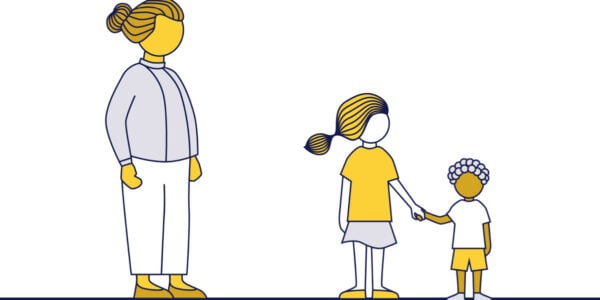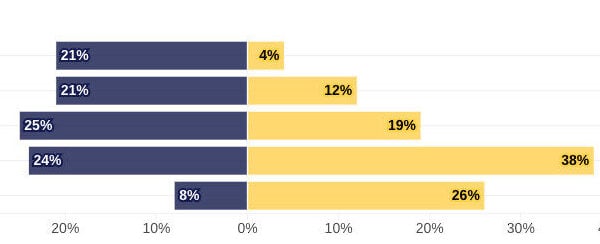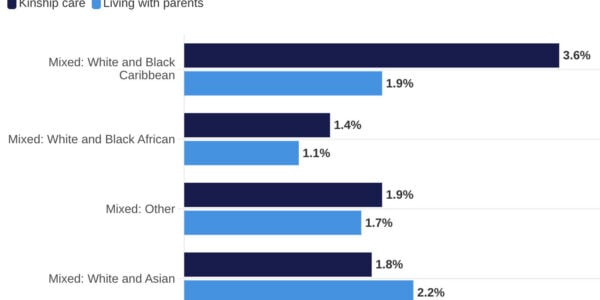Rates of public and private law per 5000 households with children per local authority per year
Private and public law cases are typically defined as in contrast—private law applications involve disputes between private individuals, whereas public law applications are brought where the dispute is between the state (or local authority) and family members. Yet both concern family disruption, both are underpinned by principles of the Children Act 1989, and both are dealt with in the single family court, which operates a common administrative framework for all family court cases.
In this article, members of the Family Justice Data Partnership Alex Lee (Research Officer in Population Data Science at Swansea University) and Linda Cusworth (Research Fellow in the Centre for Child and Family Justice Research at Lancaster University) present a series of maps and consider rates of public and private law cases in Wales, both separately and combined, including trends over time and local authority variations.
The majority of private law applications are made by separated parents, unable to agree on arrangements for their children, with a range of orders available for different circumstances. The most common is a child arrangements order (CAO), which is to regulate arrangements relating to where a child should live and/or who they should see, with prohibited steps, specific issues and enforcement orders used to direct, forbid or enforce arrangements (for a fuller discussion of private law applications in Wales see recent work by the Family Justice Data Partnership team in Cusworth et al. 2020).
Public family law encompasses cases where local authorities intervene in family life, bringing proceedings where a child is identified as suffering, or likely to suffer, significant harm (as defined by the ‘threshold criteria’ within s31 of the Children Act 1989). At the close of proceedings, the court may make any, or none, of a series of orders. These include care orders (which confer parental responsibility on the local authority, with the child placed with unrelated foster carers, kinship foster carers, or at home with parents), supervision orders (which give the local authority a role to ‘advise, assist and befriend’ the child), special guardianship orders (which give a grandparent or other potential carer parental responsibility for a child who cannot live with their birth parents) or placement orders (which enable a child to be placed with prospective adopters and deals with the issue of parental consent to adoption).
The maps below visualise the rates of family law cases per 5,000 family households (those containing dependent children) in Wales over a nine-year period between 2011 and 2019 (calendar years), with separate maps indicating rates of public law cases, rates of private law cases, and a combined rate. As shown in the key, on each map, lighter colours indicate lower rates, with a continuum through to the darkest colours indicating the highest rates. The analysis was undertaken within the Secure Anonymised Information Linkage (SAIL) Databank using data from Cafcass Cymru.
Looking at the overall picture of family law cases and variations across local authorities
Even at an initial glance at an individual year, it is clear that there are distinct variations in rates of family law cases across local authorities. For example, in 2011, rates of all family law cases vary from 37 per 5,000 family households in Flintshire to 79 per 5,000 family households in Merthyr Tydfil.
Over the period, from 2011 to 2019, the picture is largely of consistency, with the highest rates each year generally observed in the same local authorities. The South Wales ‘Valley authorities’ of Merthyr Tydfil, Bridgend, Torfaen, Neath Port Talbot, and Newport show relatively consistent and high rates of family law cases. Additionally, Rhondda Cynon Taf shows consistently high rates until 2015, and Swansea has had high rates since 2015.
Albeit from different starting points, the overall trend in all cases is of increasing demand on the courts over the period, as colours darken over time, although the trends vary by local authority. Some areas (e.g. Blaenau Gwent and Merthyr Tydfil) show an increase in family law cases between 2011 and 2013, a dip in 2014 (which coincides with the removal of legal aid eligibility from most private law cases with the introduction of the Legal Aid, Sentencing and Punishment of Offenders Act), then a steady increase to 2019; others show a gradual, relatively even increase across the period (e.g. Vale of Glamorgan), and some show little variation over time (e.g. Rhondda Cynon Taf).
We know that there are more than twice as many private law cases started each year than public law cases—the underlying data tells us that during the period between 2011 and 2019 there were 13,774 public law cases compared to 30,759 private law cases—thus the trend in overall rates of family law cases is driven more by private law. It is important, therefore, to also consider variation, both by local authority and over time, for each law type separately.
Examining public law cases
The overall trend in the rate of public law cases across Wales is a steady increase—from 15 cases per 5,000 family households in 2011 to 24 cases per 5,000 family households in 2019. But as we saw for all family law cases, there are large variations between local authorities each year—in 2011, the rate of public law cases in Wales ranged from 6 per 5,000 family households in Flintshire and Conwy to 29 cases per 5,000 family households in Merthyr Tydfil.
Although the patterns do vary, the same local authorities tend to have the highest rates each year, again mostly focused within the Valley authorities of Torfaen, Bridgend, Merthyr Tydfil, and Neath Port Talbot, and to a slightly lesser extent in Blaenau Gwent, Newport, and Swansea.
As we saw in the overall rates of family law cases, some local authorities show a steady increase in public law cases (e.g. Monmouthshire and Isle of Anglesey), some little overall variation (e.g. Pembrokeshire), and some a more bumpy or uneven trend (e.g. Cardiff and Newport), or an upturn in the most recent years (e.g. Wrexham). Of particular note are Torfaen, where the rate of public law cases more than doubled from 21 per 5,000 family households in 2011 to 49 per 5,000 family households in 2019, and Carmarthenshire, the only local authority where the rate of public law cases fell over the period, from 14 per 5,000 family households in 2011 to 8 per 5,000 family households in 2019. Previous work by the Family Justice Data Partnership team (Alrouh et al. 2019) has discussed differences in the recent trends in care proceedings for different age groups of children, particularly focused on infant cases.
Examining private law cases
When looking at rates of private law cases per 5,000 family households, we again observe significant variation between local authorities and over the period from 2011 to 2019. In 2011, rates of private law cases vary from 27 per 5,000 family households in Vale of Glamorgan to 53 per 5,000 family households in Rhondda Cynon Taf, and 55 per 5,000 family households in Bridgend.
The highest rates of private law cases tend to be seen in the same local authorities each year, including Merthyr Tydfil, Carmarthenshire, Newport, Rhondda Cynon Taf, and Neath Port Talbot.
Although some areas have high, or low, rates of both public and private law cases, others do not. For example, Carmarthenshire, Pembrokeshire and Ceredigion have relatively high rates of private law cases, but relatively low rates of public law cases. Conversely, Torfaen and Blaenau Gwent have high public law rates but relatively low rates of private law cases. So, in Torfaen for example, although the combined demand on the courts is high, the proportion of this accounted for by public law cases is greater than in other areas.
Previous work by the Family Justice Data Partnership team (Cusworth et al. 2020) examined rates of private law applications in Wales, at a national level and by court (designated family judge) areas. The same overall trend is seen here—modestly increasing rates of private law cases per 5,000 family households in Wales from 2011 to 2013, then a drop between 2013 and 2014, subsequent to the removal of legal aid eligibility for most private law cases, followed by a return to steady increasing rates. Across Wales, there were 40 private law cases per 5,000 family households in 2011, rising to 55 per 5,000 in 2013, then dropping to 40 per 5,000 family households in 2014, before steadily rising to 54 per 5,000 family households in 2019.
Using the maps, and when we examine the data at the level of the individual local authorities, a number do show this same overall trend over the period, including Neath Port Talbot, Merthyr Tydfil, Gwynedd, and Blaenau Gwent. But others do not, either showing little impact of the removal of legal aid (e.g. Monmouthshire and Torfaen), or a generally stable (e.g. Flintshire) or inconsistent trend (e.g. Isle of Anglesey and Pembrokeshire).
What the maps do and don’t tell us
By considering rates and trends in both public and private family law, we have been able to identity that combined rates are much higher in some local authority areas than others. Public and private law cases are often counted, managed or analysed in isolation, yet it is only by connecting the two that we can fully appreciate both overall demand on the family courts and other services, and the overall level of need for support amongst families. Understanding the level of need for support in different parts of Wales is also important in terms of allocation of resources and service developments.
However, at the level of the individual local authority, the rates of public and private law cases, and the balance between the two, is not always as expected. Why in some local authorities, such as Torfaen, is ‘demand’ (or need) skewed to public law? Surely in communities where families are more at risk of family difficulties on account of area-level deprivation, this would deliver high rates of both public and private law applications? Previous research has indicated a clear link between deprivation and both public and private law applications (see Johnson et al. 2020Griffiths et al. 2020Cusworth et al. 2020), yet here we see a more complicated picture when we ask questions using smaller geographies.
To answer such questions we also need to interrogate local practices, both those of family members and of professionals. Population-level statistics deliver a high-level picture of what is happening in the family justice system, but further insights require practice-focussed and family-focussed research. For example, how many public law cases are resolved through a private law application brought by a family member, for example a grandparent applying for a CAO as an alternative to the local authority bringing care proceedings? To what extent are local authorities making use of this route to permanence, and do practices vary by local authority or court area?
The Family Justice Data Partnership recently delivered an overview report of private law in Wales (Cusworth et al., 2020), greatly aided by expert input from Professor Liz Trinder, Exeter University. In this report we described an overall dip in private law cases in 2014, coinciding with the removal of legal aid entitlement for most private law cases. However, from the current analysis we see that this dip is not consistently evident across local authorities—so again the picture is more complicated and requires that researchers and analysts bring a different lens to enquiry.
There are some caveats to the data presented here. Rates of family law cases per 5,000 family households do not account for the fact that some families may be subject to more than one case within a year, sometimes both public and private law. Cases may involve more than one child, so these figures do not give us an indication of the total number of children who are affected by the family justice system. As we have also stated before, the use of the ‘per family household’ measure has some limitations, as it includes all families, not just separated families. The pursuit of a more accurate denominator for private law research is long overdue, and may require the linking of survey and administrative data. Although the use of incidence rates takes into account the size of the underlying population, it does not calibrate for the geographical size or other characteristics of local areas. The rates used here also include all public law and all private law cases, and there is a need to differentiate this further, focusing on specific or the most common application types, such as child arrangements, care and supervision.
The use of maps to visualise rates of family law cases, together with trends over time and geography, has enabled new insights into family law need and demand, but raises further questions about the drivers and variations, and the impact on children, families, the courts, and other services.




